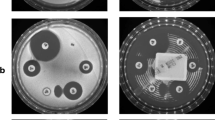Abstract
Five systems for identifying Enterobacteriaceae were evaluated in terms of their ability to provide reproducible results. Frozen microdilution panels (Micro-Media Systems), prepared media ready for dispensing into microdilution trays (Dynatech laboratories), media prepared in our laboratories and dispensed into microdilution trays (UC media), the Micro-ID system (General Diagnostics), and the API 20E system (Analytab Products, Inc.) were all evaluated. Fifty selected isolates were tested with each system on three separate days. Although biotypes were some-what variable, the final identification was rarely affected. The API 20E system was the most variable and microdilution tests, with UC media, were the least variable. Precision of tests performed in microdilution trays was as good, if not better than, that obtained with the other two commercial products (Micro-ID and API 20E).
Similar content being viewed by others
Literature Cited
Barry, A. L., Badal, R. E. 1979. Rapid identification ofEnterobacteriaceae with the Micro-ID system versus API 20E and conventional media. Journal of Clinical Microbiology,10:293–298.
Blazevic, D. J., Mackay, D. I., Warwood N. M. 1979. Comparison of Micro-ID and API-20E systems for identification ofEnterobacteriaceae. Journal of Clinical Microbiology9:605–608.
Brenner, D. J., Farmer, J. J., Hickman, F. W., Ashbury, M. A., Steigerwalt, A. G. 1977. Taxonomic and nomenclature changes inEnterobacteriaceae. Publication No. CDC 78-8356. Atlanta: U. S. Department of Health, Education, and Welfare.
Butler, D. A., Lobregat, C. M., Gavan, T. L. 1975. Reproducibility of the Analytab (API-20E) system. Journal of Clinical Microbiology2:322–326.
Edwards, P. R., Ewing, W. H. 1972. Identification ofEnterobacteriaceae, 3rd. ed. Minneapolis: Burgess.
Murray, P.R. 1978. Standardization of the Analytab Enteric (API-20E) system to increase accuracy and reproducibility of the test for biotype characterization of bacteria. Journal of Clinical Microbiology8:46–49.
Rutherford, I., Moody, V., Gavan, T. L., Ayres, L. W., Taylor, D. L. 1977. Comparative study of three methods of identification ofEnterobacteriaceae. Journal of Clinical Microbiology5:458–464.
Barry, A. L., Badal, R. E., Effinger, L. J. 1979. Identification ofEnterobacteriaceae in frozen microdilution trays prepared by Micro-Media systems. Journal of Clinical Microbiology10:492–496.
Kelly, S. A., Washington, J. A. 1979. Evaluation of the Micro-Media system for identification of Enterobacteriaceae. Abstracts of the Annual Meeting of the American Society for Microbiology1979:334.
Author information
Authors and Affiliations
Rights and permissions
About this article
Cite this article
Barry, A.L., Badal, R.E. & Effinger, L.J. Reproducibility of three microdilution systems for identification of enterobacteriaceae, compared with API 20E and micro-ID test systems. Current Microbiology 3, 21–25 (1979). https://doi.org/10.1007/BF02603128
Issue Date:
DOI: https://doi.org/10.1007/BF02603128




